We kindly inform you that, as long as the subject affiliation of our 300.000+ articles is in progress, you might get unsufficient or no results on your third level or second level search. In this case, please broaden your search criteria.
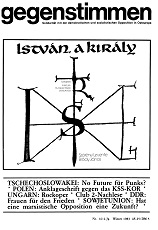
Der Gegenwart mit der Vergangenheit beizukommen, ist ein für Ungarns Musikschaffende bereits bestens erprobtes Stilmittel: Die Nationaloper »Banus Bank« von Ferenc Erkel — in der zweiten Hälfte des 19. Jahrhunderts, nach der Niederwerfung der bürgerlich-demokratischen Revolution 1848 geschrieben — enthielt ebenso flammende Appelle der nationalen Unabhängigkeit, wie es Verdi etwas früher verstanden hatte, den Gedanken des nationalen »Risorgimento« der Italiener musikalisch zu fasjsen.
More...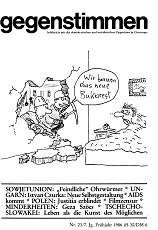
Die Kammerjäger im Auftrag des ZK und des Ministeriums für Kultur standen diesmal vor einer besonders schwierigen Aufgabe: An den wachsamen Augen und Ohren der Hüter des sozialistischen Plakatrealismus vorbei hatte sich allerlei künstlerisch schwaches Ungeziefer in die ideologisch nicht gefestigten Köpfe der sowjetischen jungen Generation geschlichen. Dort schwirrten sie und surrten sie herum, gesteuert von den elektromagnetischen Impulsen ihrer Absender, den Brutstätten minderwertiger Musik und provokant-schnoddriger Kommentare über die Wünsche und Gefühle der dekadenten young generation of the western and eastern world. „Hallo, molodzy“, meldet sich Abend für Abend eine propagandistisch- angeheizte Stimme aus dem westlichen Äther, die aus dem Roman Clockwork Orange des sozialkritischen Autors Burrough gesprungen sein könnte.
More...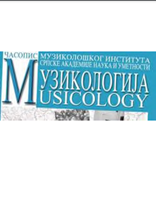
Ljubica Marić belongs to (hose rare Serbian composers who were fully involved in the international developments of modern music during the thirties I ler output shows that she was able to take over some dominant ideas of the period and transform them in a personal way. In the article are investigated all four of her preserved works composed before the outbreak of Work! War 2. Among them are two compositions that were until recently' believed to be lost: Longing for the (Hr! for choir (1929) and Music for orchestra (1932).
More...
Thanks to the works of George Enescu. Romanian music achieved its first breakthrough onto the European scene in the years preceding World War I. In the inter-war period the number of Romanian composers who joined modern trends, often without breaking their links with nationalism, significantly grew in number: Mihail Jora. Sabin Dragoi. Mihail Andricu. Marcel Mihalovici. among others. The music of Stravinski and Bartók produced the strongest impact on Romanian music of the 1920‘s and 1930’s.
More...
The study brings to the forefront some reference information on the connections of national oral music with the European space. The sources of documentation, to which we turn, allow a first finding, according to which our music enters the attention of the West in the XVI century. Firstly, we refer to the first records of folklore, which appeared in publications in Poland, Germany and France, and which are found in tabulations, anthologies and (or) collections of music. Once they have come out of print and have been put into circulation, they reach the creative laboratory of European artistic personalities, who have gone on to capitalize on our ethnic music in various forms and genres. We catalog some creations through concrete examples, having as a source of suggestion the local melody. Along the way, the actual musical documents from the period under investigation are supplemented with data and information from adjacent fields. The paper takes into account the contribution of foreign authors in a limited period of time (XVI–XVII centuries), who through their contribution have facilitated the promotion of the originality of our musical culture, increasing its visibility and value on the European continent.
More...
The study aims to identify the main theoretical and methodological criteria, important in shaping the scientific vision applied to the approach of the subject. The author delimits two distinct periods in the evolution of the singer’s repertoire: the late Soviet period (1968–1991) and the post-Soviet period (1991–1999). The main focus is on the Soviet epoch. Among the documentary sources are the materials stored in the IPNA archive – “Teleradio-Moldova” Company, the personal files of the artists, the minutes of the Artistic Council, the musical scores, the library of the editorial offices within the institution. To substantiate the theoretical framework of the study, the author argues the need to instrumentalize the concepts of „Soviet folk song”, „mass song”, „creator&producer networks”, „modernization”, „revitalization”, „invented traditions”, „folklorization”, „new folk songs”, „neo-traditional music”.
More...
With the annexation of Bessarabia to the USSR, the process of professionalization of accordionists, convering all levels of artistic education in the country, is influenced by the evolution of performing arts in Eastern Europe (especially Russia, Belarus, Ukraine). The academic bases are consolidated by illustrious pedagogues, such as Iziaslav Birbraier, Valentin Zagumionov (I. Birbraier’s student), Ivan Folomkin (one of the first graduates of the Gnesin State Musical-Pedagogical Institute in Moskow) and others. Durind the years 1940–1960, the establishment of the accordion interpretive art in the Moldavian SSR was directly conditioned by the massive ideologization of the ex-Soviet cultural space, which largely blurred the national identity aspect in the accordion academization process. Based on the classical-romantic aesthetics „adjusted” by the doctrine of socialist realism, the professionalization of Bessarabian instrumentalists is distinguished by a prominent conservatism compared to other accordion schools of that period, such as German, Danish, Czech etc. (we refer primarily to the compositional domain). Even if in this time segment the accordion failed to fully integrate into the „family” of European academic instruments, taking into account some areas (organological, compositional, pedagogical, interpretive) that needed to be intensely perfected, the first postwar decades can still be considered the reference point for establishing the academic status of chromatic harmonics in the Moldavian SSR.
More...
The present paper starts from the idea of “archival return” in scientific discourse and its possible uses in choreographic practice. In Poland, many choreographers have tried to reconstruct the works of famous artists from the 20s and 30s of the XX century. The works of Pola Nireńska, Yanka Rudzka and Marie Rambert are brought to the stage from today’s perspective. This phenomenon would contribute to the completion of a history with new valences. In the context of reconstructing the choreography of the past, we will refer to the memory of the body and “the body as an archive”. We will analyze how contemporary choreographers work with memory and bodily memories, trying to find traces to get in touch with historical stagings. The research is based on the concept of the body as an archive and the experience of previous generations in choreographic practice. At the same time, we will try to find the answer to the question: how is the process of including choreography in the archival context treated and how does it manifest itself as such today. We will highlight the connection with the past, but also the contribution to knowing and promoting choreographic values.
More...
Tranziția la era digitală în secolul XXI este un fapt inevitabil și ireversibil, iar ceea ce privește transferul în zona virtuală aceasta nu mai este o noutate. Cu toate acestea, odată cu situația pandemică provocată de noul Corona virus COVID 19 în rețeaua artistică festivalieră în sfera artelor vizuale, film și muzică s-a accelerat sau chiar a forțat schimbarea formatului de produs cultural, la nivel de prezentare și experiență.
More...
The study „Sergei Cretu and neo-traditional music: the creative path in the Soviet period” sketches a brief portrait of the artist, highlighting the important biographical data on specialized studies, the context of professional evolution in the Soviet period of the 1960s-1980s, marked by the so-called „new wave of folklore”. Special emphasis is placed on the refl ection of his activity as a dulcimer player, arranger and composer in the Popular Stage Orchestra and in the „Folclor” Orchestra of the Moldovan Republican Television and Radio Broadcasting Company. Th e main compartments and aesthetic directions in the his interpretive and compositional creation, the structure of the genres and styles, including the place, the sources and the social motivations of the works of Soviet ideological inspiration and instrumentalization are also highlighted. Th e study capitalizes on documents, data and information from the Archive of the „Teleradio-Moldova” Company, materials from the press of the time, audio and video sources as well as a series of concepts from modern specialty literature, able to promote the interpretation and analysis of cultural facts.
More...
In this article is analyzed the correlation of the concepts of music and identity is analyzed, in which music lends itself as one of the key elements of identity, because it off ers a perception of the self, but also of the collective. Th e concept of musical identity was the main focus in the creation of new national musical schools (Eastern Europe). Musical compositional creation that tended to embody tradition has served as a powerful cultural resource for nationalism since the 19th century. Th e compositional vector was directed, on the one hand, to get out of the crisis of the romantic music trend, and on the other hand, to strengthen the new national schools in the states of Eastern Europe, where the academic musical culture was at a relatively young stage. In the post-romantic crisis, the appeal to formulas of folklore origin brought a new breath, diversifying the musical language and the means of expression, in order to affi rm musical cultures (Poland, Hungary, Czech Republic, Bulgaria, Romania), etc. Th e new states, previously under the infl uence of the great empires, distanced themselves somewhat from Western musical culture, a fact that allowed, on the one hand, the creation of national schools and the preservation of traditions in the conditions of essential changes in European, pan-European and world composition.
More...
The present article analyses the performances of the Moldovan Academic Musical Dramatic State Th eater „A.S. Pushkin” staged in the 1970s, in which cultural and civic identities were manifested, and namely: Egor Bulâciov and others by M. Gorki, Th e tiger and the hyena by S. Petőfi , Th e armored train 14-69 by Vs. Ivanov, Romeo and Juliet by W. Shakespeare, On the Night of a Moon Eclipse by M. Karim, Th e Inspector General by N. Gogol, Beyond the Green Door by R. Ibraghimbekov, Th e Blue Deer by A Kolomieț, An interview in Buenos Aires by H. Borovik, Servant to two masters by C. Goldoni, As long as we are going live by O. Iosseliani, Th e Prize by A. Ghelman, Night Asylum by M. Gorki, Solo for the clock by O. Zagradnic, the trilogy Th e Paths, A boat in the forest and Th e Dogs by N. Haitov, Th e Lark by J. Anouilh. Th e article also examines the shows marked by cultural, national and civic identities, among them: Love is not a bad counsel by A. Marinat, Th e Birds of our youth by I. Druță, Two girls and a nanny by V. Alecsandri, Th e Leader by D. Matcovschi, Childhood Memories and Harap Alb (Once upon a time…) by I. Creangă, Father by D. Matcovschi.
More...
If the 18th century initiated - through Psaltichia Rumănească by Filotei sin Agăi Jipei - the process of autochthonization of psalter singing in the Romanian area, and then it ensured its upward course, the first half of the 19th century marks the zenith of the approach, bringing in the foreground personalities such as Macarie Hieromonk and Anton Pann. Both the Macarian concept of Romanization of sacred singing, as well as Anton Pann’s achievements in this domain, have a certain artistic and instructive value and, in their time, were affirmed as attitudes and models to follow. At the same time, the current Byzantinistics insists on the limited character of these contributions, showing that the two precursors only referred to Constantinopolitan singing after 1814 and did not capitalize on the old autochthonous liturgical music, did not take into account the psalter singing from villages, close to the folkloric matrix. They aimed especially at the text of the pew singing and not at the musical background, which changes only to a small extent.
More...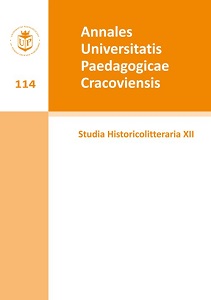
The author traces the influences of the Battle of Grunwald, 1410 (understood as a cultural artifact) in various works of art. The religious hymn Bogurodzica (Mother of God), known already before the Battle, after 1410 gained the status of national anthem, promoted by the chronicler’s account of the event. The Battle of Grunwald features in Polish literature, painting, music, film and even in the latest tools for communication and education (board games, the Internet). The article serves as an introductory sketch to the complex issue of the significance of the mythologised Polish victory in the development of Polish artistic culture.
More...
The article is one more study within the series presenting the cultural life of the Polish emigration, in the broadest sense of the word, during World War II, as written about in the London "Dziennik Polski in 1940-1943, i.e. before merging with "Dziennik Żołnierza". It analyses the music and the theatre. It argues that the Poles-artists, everyone of them, to the best of their abilities, got actively involved in the struggle to maintain the vitality of the Polish cause on the international arena during the discussed period. They accomplished that through organizing regular concerts and recitals in Great Britain, the United States, in the Middle East, or in Africa; promoting the Polish music by Fryderyk Chopin, Ignacy Paderewski (including his patriotic political activity) and Stanisław Moniuszko; presenting the profiles of the contemporary Polish composers living abroad, as for example Henryk Opieński; organizing fundraisers for the Polish prisoners of war; organizing theatre and ballet performances. Glorification of the national composers and performers was also meant to augment the national pride, and to build the sense of national community in the traumatic time of war.
More...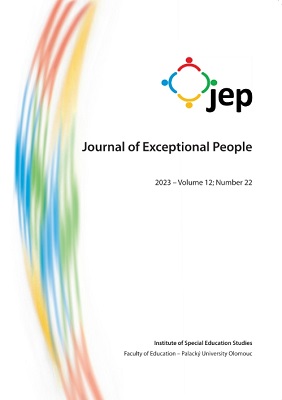
Review of: -Phil Jones, The Arts Therapies: A Revolution in Healthcare | Polly Bowler, Rachael Hood, Eleanor Keiller, Helen O’Loughlin, Katherine Rothman | 2022, Book review | First published online February 15, 2022
More...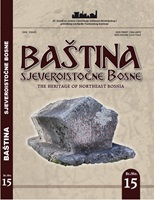
In the period between the two world wars, there were no musical groups in northeastern Bosnia schools. In Bosnia and Herzegovina, since 1920, the only regional music group has been active in Sarajevo school. The most significant activity in musical life in this period was performed by performers ensembles. Mostly, these were choirs that worked for singing societies and others instrumental orchestras and ensembles. For the reasons mentioned, there was a need for research, by collecting, revealing and analyzing data, with the basic goal of seeing the facts about activities of singing societies in this period and their contribution to the development of musical culture.
More...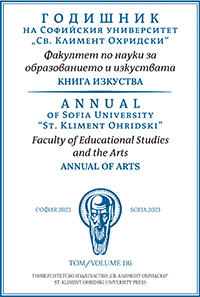
The article considers, for research purposes, the role and the meaning of the lyrics (words) in the vocal-instrumental genres of the English-speaking world, emphasizing its content and meaning. A counterpoint to this type of musical genre is instrumental music, which in specific cases is used as an opportunity to compare different musical forms. Special attention is paid to the sung words in the musical works of the English-speaking world in the context of the distinction between speech and language.
More...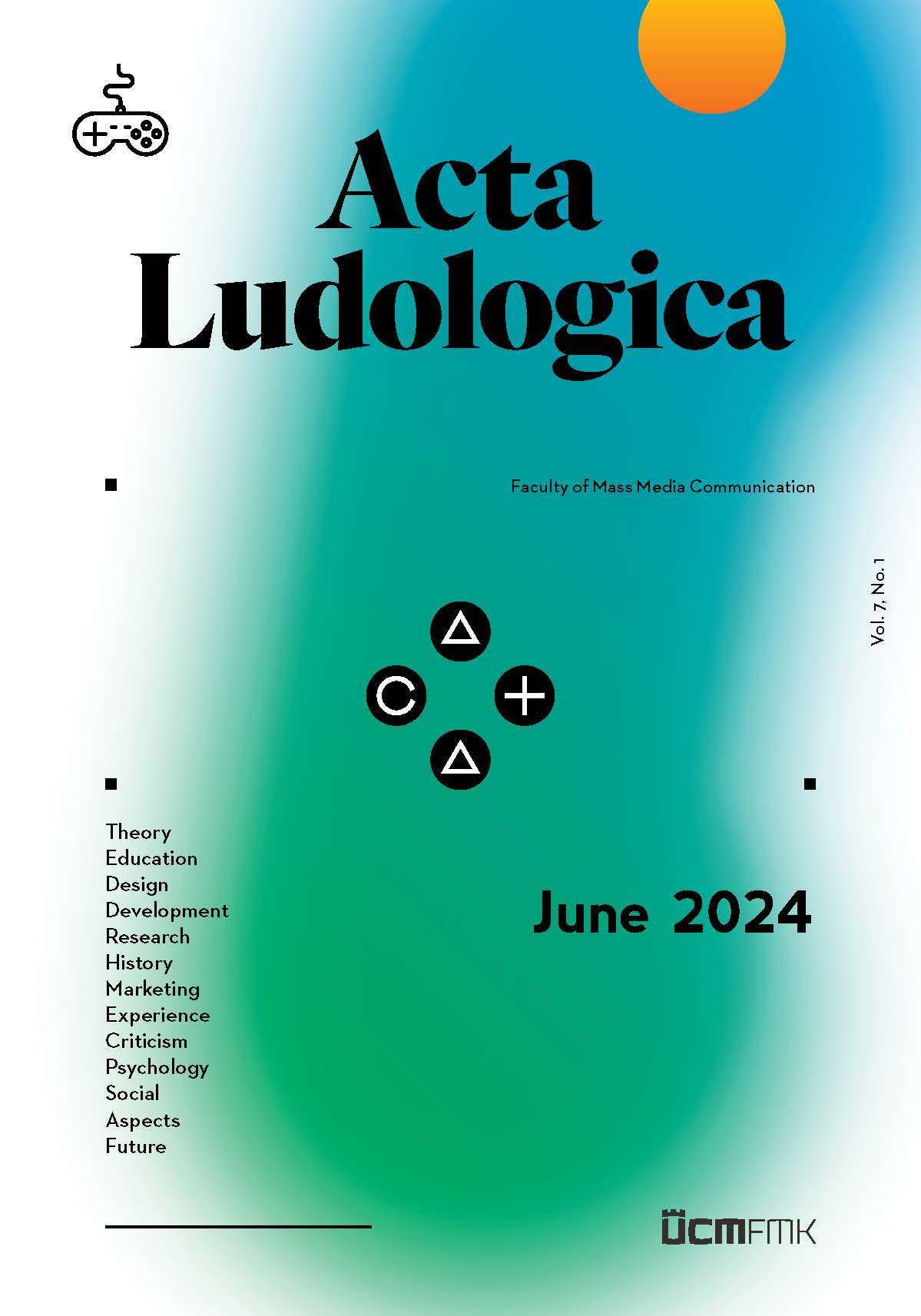
The article seeks to establish a foundational framework for comprehending crucial definitions and concepts related to auditory space in digital gaming, particularly focusing on audio games designed for visually impaired individuals (VI), often devoid of graphical interfaces. While existing studies often emphasize players’ interactions with interfaces and the acquisition of real-life skills, this text explores audio games through the lens of entertainment and immersion. Numerous studies indicate a demand among visually impaired players for more intricate and challenging games, incorporating elements usually used in standard digital gaming experiences. By combining definitions from both audio and traditional digital games, this article broadens the scope of sound design considerations, encompassing various aspects and classifications. It presents several auditory dimensions, consolidating them into a comprehensive dimension called attenuation, putting their roles within a game’s context. The author is a sound designer currently working on an audio game; therefore, many of the presented definitions are also a guide that will represent some of his own considerations while working on this game. These include not only the use of binaural or ambisonic sound but also understanding the ways and means of how to work with (3D) space in the context of audio and its possible functions.
More...